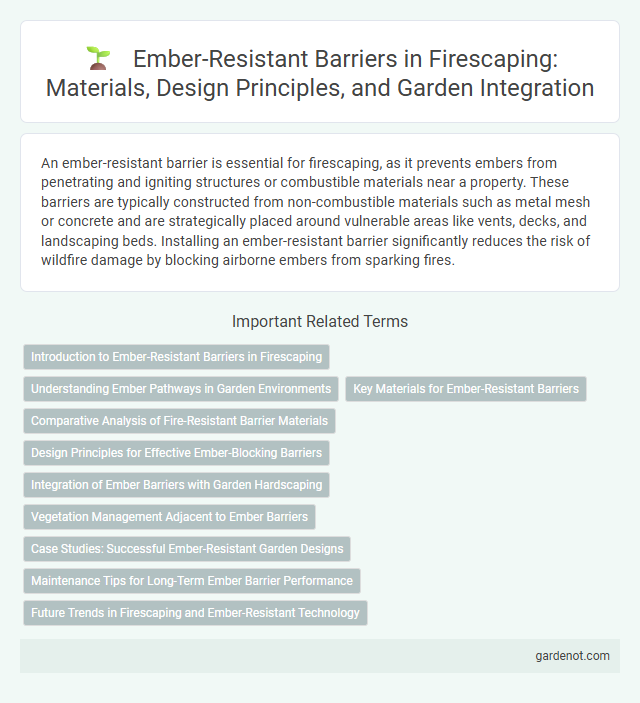An ember-resistant barrier is essential for firescaping, as it prevents embers from penetrating and igniting structures or combustible materials near a property. These barriers are typically constructed from non-combustible materials such as metal mesh or concrete and are strategically placed around vulnerable areas like vents, decks, and landscaping beds. Installing an ember-resistant barrier significantly reduces the risk of wildfire damage by blocking airborne embers from sparking fires.
Introduction to Ember-Resistant Barriers in Firescaping
Ember-resistant barriers are critical components in firescaping designed to prevent embers from penetrating and igniting structures during wildfires. These barriers typically consist of non-combustible materials such as metal mesh, fire-resistant fabrics, or specialized screens that block ember intrusion while allowing airflow. Installing ember-resistant barriers around vents, eaves, and other vulnerable points significantly reduces the risk of ember-driven ignition, enhancing overall wildfire resilience.
Understanding Ember Pathways in Garden Environments
Ember-resistant barriers play a crucial role in firescaping by interrupting ember pathways that can ignite garden environments. Understanding common ember entry points such as vents, gaps in fencing, and exposed wood surfaces helps in strategically placing these barriers to minimize fire risk. Incorporating fire-resistant materials and sealing vulnerable areas significantly reduces the likelihood of ember-driven ignitions near homes and landscapes.
Key Materials for Ember-Resistant Barriers
Key materials for ember-resistant barriers include non-combustible metals such as steel and aluminum, which provide robust protection against flying embers. High-temperature resistant mesh screens made from stainless steel or copper prevent ember intrusion while allowing airflow. Fire-resistant mineral-based boards and cementitious panels further enhance barrier durability and fire resistance in firescaping designs.
Comparative Analysis of Fire-Resistant Barrier Materials
Ember-resistant barriers such as fiber cement panels, mineral wool insulation, and gypsum sheathing offer varied levels of fire resistance and durability in firescaping applications. Fiber cement panels excel with their non-combustible composition and high thermal stability, while mineral wool insulation provides excellent fire resistance combined with soundproofing properties. Gypsum sheathing, commonly used in construction, offers a cost-effective fire-resistant barrier but typically has lower durability and fire endurance compared to fiber cement and mineral wool.
Design Principles for Effective Ember-Blocking Barriers
Ember-resistant barriers must incorporate non-combustible materials and tightly sealed joints to prevent ember penetration, ensuring continuous protection against airborne firebrands. Designing multi-layered barriers with overlapping seams enhances the structural integrity and blocks ember ingress more effectively. Strategic integration of ventilation screens with fine mesh size, typically 1/8 inch or smaller, balances airflow while minimizing ember entry, critical for reducing ignition risks in wildland-urban interface zones.
Integration of Ember Barriers with Garden Hardscaping
Integrating ember-resistant barriers with garden hardscaping enhances wildfire defense by blocking windborne embers from landing on combustible surfaces like mulch and dry plants. Using materials such as non-combustible stone, metal mesh barriers, and fire-resistant pavers creates a continuous protective zone that significantly reduces ember intrusion. This synergy between ember barriers and hardscape elements effectively minimizes ignition risks, protecting homes and landscapes from ember-driven fires.
Vegetation Management Adjacent to Ember Barriers
Vegetation management adjacent to ember-resistant barriers is critical for reducing wildfire risk by minimizing fuel sources near structures. Maintaining a clear zone of low-flammability plants and regularly removing dead or dry vegetation prevents embers from igniting fires near protective barriers. Proper spacing and selection of fire-resistant plant species enhance the effectiveness of ember barriers in creating defensible spaces.
Case Studies: Successful Ember-Resistant Garden Designs
Numerous case studies highlight the effectiveness of ember-resistant barriers in garden designs, showcasing how strategically placed non-combustible materials like stone, gravel, and fire-resistant plants significantly reduce ember intrusion. These successful implementations demonstrate a marked decrease in fire spread, protecting properties by creating defensible spaces that inhibit ember accumulation. Data from wildfire-prone regions confirm that gardens incorporating ember-resistant barriers achieve higher safety ratings and lower damage reports during fire events.
Maintenance Tips for Long-Term Ember Barrier Performance
Regular inspection and prompt repair of ember-resistant barriers are essential to maintain their effectiveness against wildfire embers. Clear debris accumulation and prevent moisture buildup to avoid barrier degradation and preserve fire resistance. Use non-combustible sealants to reinforce gaps and ensure continuous ember protection over time.
Future Trends in Firescaping and Ember-Resistant Technology
Future trends in firescaping emphasize the integration of advanced ember-resistant barriers that significantly reduce wildfire exposure to properties. Innovations in materials science are leading to barriers with enhanced thermal resistance and durability against ember penetration, improving overall fire survivability. These technologies are becoming essential components in modern landscape design and building codes to mitigate ember-driven fire risks.
Ember-resistant barrier Infographic

 gardenot.com
gardenot.com